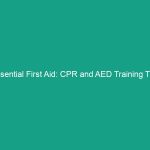Introduction
Good morning team! Today, we’re going to talk about an essential tool that many of you use daily: shears. Understanding the essential guidelines for the safe use of shears is crucial for maintaining a safe and productive work Environment. Using shears improperly can lead to serious injuries, so let’s dive into why it’s important to adhere to Safety practices when using them.
Understanding Essential Guidelines for Safe Use of Shears
The phrase “Essential Guidelines for Safe Use of Shears” refers to the set of practices and Procedures designed to protect users from accidents and injuries associated with shears. These guidelines are vital in ensuring the Safety of all employees who handle these tools regularly. By understanding and applying these guidelines, we can minimize risks and ensure a safer workplace environment.
Many employees might think that using shears is straightforward and doesn’t require much thought. However, this misconception can lead to avoidable accidents. It’s important to remember that even common tools can pose risks if not used correctly.
Key Hazards, Risks, and Safety Considerations
When using shears, there are specific Hazards and risks that you need to be aware of:
- Cutting Injuries: Sharp blades can easily cause cuts or lacerations if mishandled.
- Pinching: Improper handling may result in pinching of fingers or skin.
- Inadequate Personal Protective Equipment (PPE): Not wearing the right PPE can increase the risk of injury.
- Distraction: Working in a busy environment can lead to distractions, increasing the chance of accidents.
Ignoring safety protocols can lead to serious injuries, affecting not just the individual but the entire team. For example, a colleague who suffered a laceration from a shear may require time off work, impacting productivity and team morale.
Best Practices, Procedures, & Actionable Advice
To ensure the safe use of shears, here are the Best Practices you should follow:
1. Always Use the Right Tool for the Job
Make sure you are using the appropriate type of shear for your task. Each shear is designed for specific materials; using the wrong shear can lead to accidents.
2. Inspect Your Shears Before Use
Before using shears, inspect them for any damage. Look for:
- Sharpness of the blades
- Loose or broken parts
- Rust or corrosion
If you find any issues, report them immediately and do not use the tool until it is repaired.
3. Maintain a Clean Workspace
Ensure that your work area is clean and free of unnecessary clutter. A tidy workspace reduces the risk of accidents significantly.
4. Use Proper Grip and Cutting Technique
Always use a firm grip on the handles of the shears and cut away from your body. This technique minimizes the risk of injury if you slip while cutting.
5. Wear Personal Protective Equipment (PPE)
Ensure you are wearing appropriate PPE, including:
- Cut-resistant gloves
- Safety glasses
- Long sleeves to protect your arms
6. Store Shears Properly
When not in use, always store shears in a designated area where they cannot be accidentally accessed by unauthorized personnel. Use shears with protective covers when storing them.
Regulations, Standards, and Compliance
It’s important to keep in mind that using shears safely is not just about individual responsibility; it’s also about compliance with Regulations and Standards. OSHA regulations require that tools and equipment are maintained and used safely. Compliance with these regulations not only protects you but also helps foster a culture of safety within the workplace.
Employee Engagement & Discussion
Now that we’ve gone over the essential guidelines, let’s open the floor for discussion. Here are a few questions to consider:
- Have you ever experienced an incident with shears? What could have been done differently?
- What safety challenges do you face when using shears in your daily tasks?
- How can we improve our safety practices related to the use of shears?
Feel free to share your thoughts or experiences; your input is valuable in enhancing our safety culture.
Conclusion & Key Takeaways
In conclusion, the essential guidelines for safe use of shears are crucial for preventing injuries and ensuring a safe working environment. Remember to:
- Use the right tool for the job.
- Inspect tools before use.
- Maintain a clean workspace.
- Wear appropriate PPE.
- Store shears properly.
By applying these practices, you not only protect yourself but also your colleagues. Thank you for your attention and commitment to safety. Let’s make safety our top priority every day!


